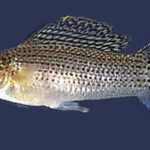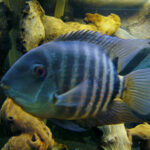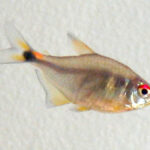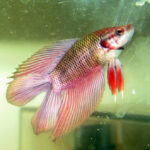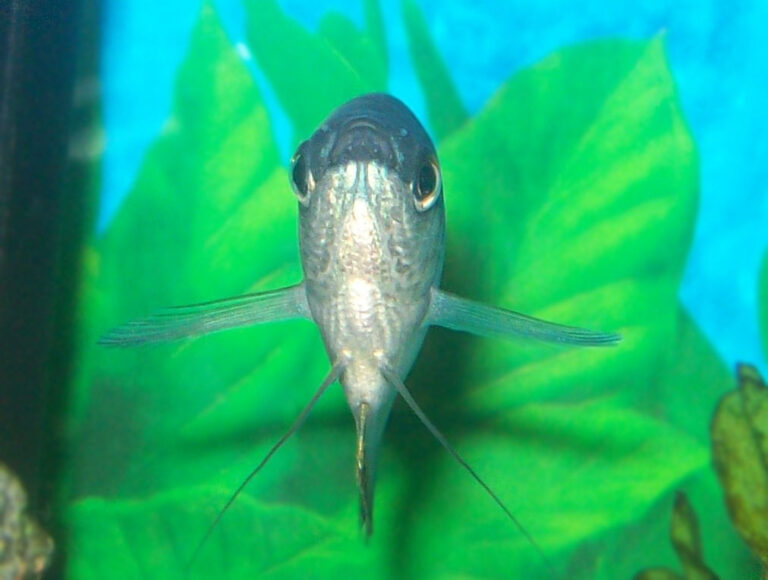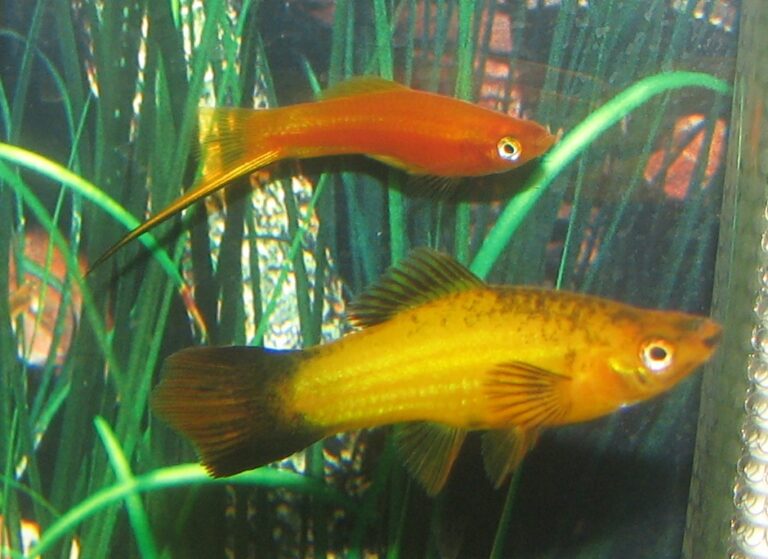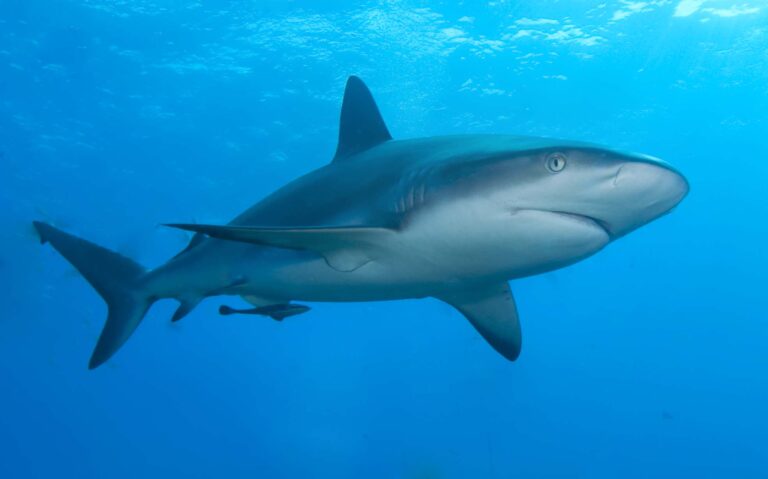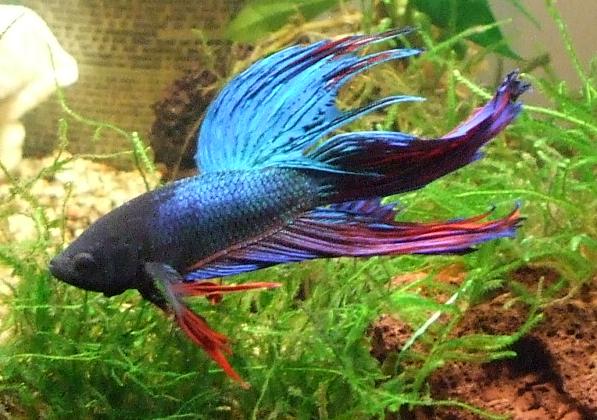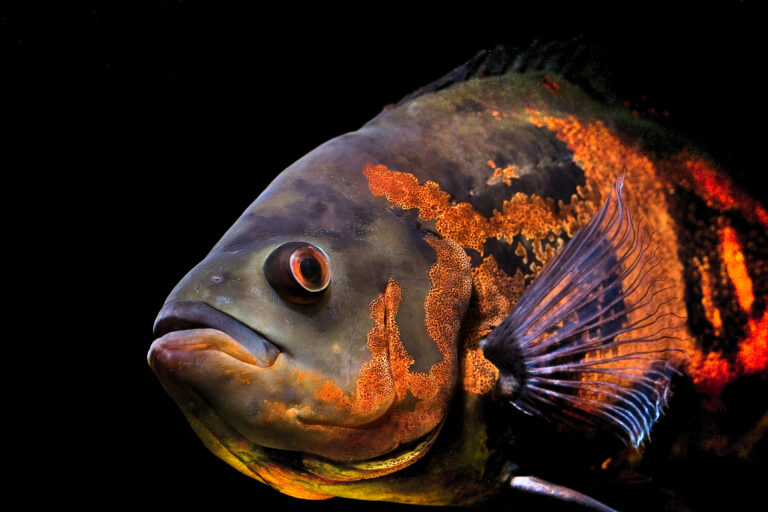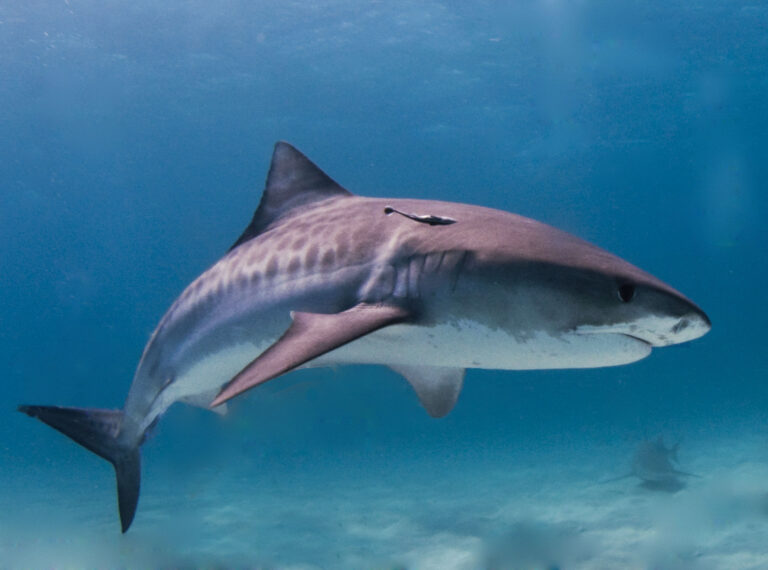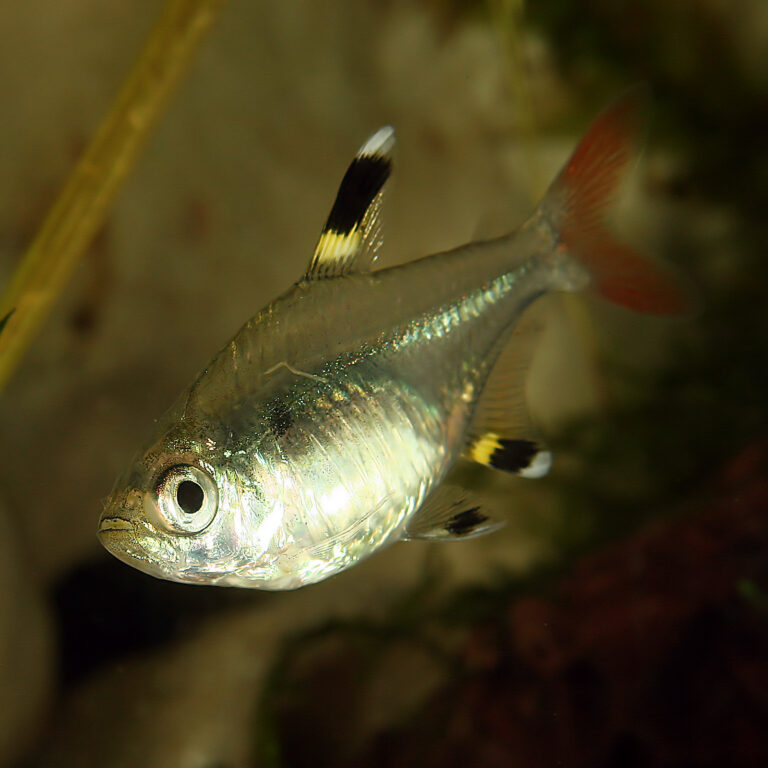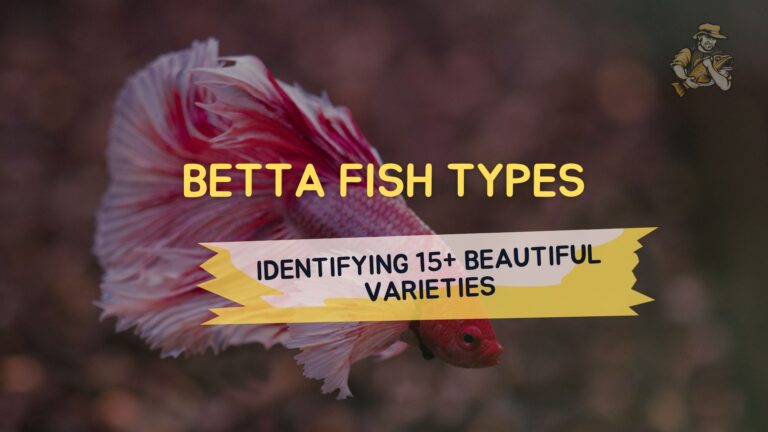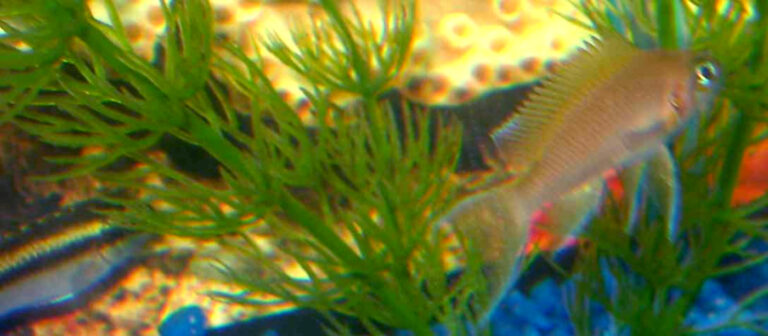Jaguar Cichlid
By Ryan Maron | Last Modified: June 9, 2025
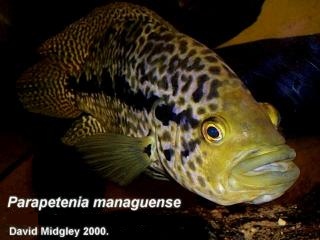
The Jaguar Cichlid stands as one of Central America’s most formidable predatory fish, renowned for its impressive size, aggressive temperament, and striking appearance. This remarkable cichlid species, scientifically known as Parachromis managuensis, commands attention in both its native habitats and the aquarium trade. Named for its distinctive spotted pattern that resembles a jaguar’s coat, this species plays a crucial role as an apex predator in the freshwater ecosystems of Central America.
The ecological significance of the Jaguar Cichlid extends far beyond its impressive physical attributes. As a dominant predator in its native range, it helps maintain the delicate balance of aquatic food webs by controlling populations of smaller fish species. This cichlid’s presence influences the behavior and distribution of numerous other fish species, making it a keystone species in many Central American river systems and lakes. The species has also gained considerable importance in the aquarium trade, though its large size and aggressive nature make it suitable only for experienced aquarists with appropriate facilities.
| Feature | Details |
|---|---|
| Common Name | Jaguar Cichlid |
| Scientific Name | Parachromis managuensis |
| Family | Cichlidae |
| Typical Size | 35-55 cm (14-22 inches), 1.5-4 kg |
| Habitat | Freshwater lakes and rivers |
| Diet | Piscivorous predator |
| Distribution | Central America, Costa Rica to Honduras |
| Conservation Status | Least Concern |
Taxonomy & Classification
The Jaguar Cichlid belongs to the family Cichlidae, one of the most diverse fish families in the world. Within this family, it is classified under the genus Parachromis, which contains several large, predatory cichlid species native to Central America. The species was first described by Günther in 1867, and its scientific name pays homage to Lake Managua in Nicaragua, where early specimens were collected.
The genus Parachromis includes four recognized species, with P. managuensis being the most widespread and commercially important. The classification places this species within the subfamily Cichlinae, which encompasses the large-bodied, predatory cichlids of the Neotropics. Recent molecular studies have confirmed the monophyletic nature of the Parachromis genus, supporting its distinct evolutionary lineage within the cichlid family tree.
Taxonomic relationships within the Parachromis genus remain an active area of research, with ongoing studies examining the genetic diversity and evolutionary history of these species. The Jaguar Cichlid’s position within the broader cichlid phylogeny reflects the rapid adaptive radiation that has characterized this family throughout Central and South America. Understanding these relationships is crucial for conservation efforts and proper management of wild populations.
Physical Description
The Jaguar Cichlid exhibits remarkable sexual dimorphism and distinctive physical characteristics that make it easily recognizable among Central American cichlids. Adult males typically reach lengths of 45-55 centimeters and can weigh between 2.5-4 kilograms, while females generally remain smaller at 35-45 centimeters and 1.5-2.5 kilograms. The species displays a robust, laterally compressed body with a pronounced hump on the forehead of mature males, a characteristic feature that becomes more prominent with age.
The coloration of Jaguar Cichlids varies significantly based on age, sex, and environmental conditions. Juvenile specimens display a golden-yellow base color with prominent black spots scattered across the body and fins. As they mature, the base coloration often shifts to a more subdued gray or olive-green, while the spots may become more pronounced or fade depending on breeding condition and dominance status. The distinctive spotted pattern, reminiscent of a jaguar’s rosettes, extends from the head to the caudal fin, creating the namesake appearance that makes this species so recognizable.
The head structure of the Jaguar Cichlid reflects its predatory nature, featuring a large mouth equipped with powerful pharyngeal teeth capable of crushing smaller fish and crustaceans. The eyes are proportionally large and positioned to provide excellent binocular vision for hunting. The dorsal fin is elongated and may display elaborate extensions in mature males, while the anal fin often features distinctive coloration patterns that intensify during breeding periods.
Habitat & Distribution
The natural range of the Jaguar Cichlid extends throughout Central America, from Costa Rica in the south to Honduras in the north, encompassing the Atlantic slope drainages of Nicaragua, Costa Rica, and parts of Panama. The species inhabits both lentic and lotic environments, showing remarkable adaptability to various freshwater habitats including large lakes, slow-moving rivers, and associated wetland systems.
In their native range, Jaguar Cichlids prefer areas with moderate water flow and abundant structural complexity. They are commonly found in areas with submerged logs, rocky outcrops, and dense aquatic vegetation that provide both hunting opportunities and territorial boundaries. The species demonstrates a preference for water temperatures between 24-28°C and pH levels ranging from 6.5 to 8.0, though they can tolerate broader ranges when necessary.
Lake Managua and Lake Nicaragua represent some of the most significant natural populations of Jaguar Cichlids, where they have co-evolved with other endemic cichlid species. These large lake systems provide the expansive territories and abundant prey resources necessary to support healthy populations of this large predatory species. The species has also established populations in various reservoir systems created by dam construction throughout their range, demonstrating their ability to adapt to human-modified environments.
Water quality parameters in their natural habitat typically include dissolved oxygen levels above 5 mg/L, moderate hardness levels, and seasonal temperature fluctuations that trigger breeding behaviors. The species shows remarkable tolerance to environmental variability, which has contributed to its success in both wild and captive environments.
Diet & Feeding Behavior
The Jaguar Cichlid is primarily a piscivorous predator, with fish comprising 70-80% of its natural diet. Their feeding strategy combines active hunting with opportunistic scavenging, allowing them to exploit various prey species and feeding opportunities. Juvenile Jaguar Cichlids begin their lives feeding on small invertebrates, zooplankton, and insect larvae before transitioning to a fish-based diet as they mature.
Adult Jaguar Cichlids employ several hunting techniques depending on prey availability and environmental conditions. They are known to engage in ambush predation, positioning themselves near structural cover to surprise unsuspecting prey fish. The species also demonstrates pursuit predation capabilities, actively chasing down smaller fish in open water. Their powerful pharyngeal apparatus allows them to process relatively large prey items, with some individuals capable of consuming fish up to 30% of their own body length.
The diet composition varies seasonally and geographically, reflecting prey availability and local ecosystem dynamics. During spawning seasons of prey species, Jaguar Cichlids may focus heavily on consuming eggs and fry, while during periods of low fish abundance, they increase their consumption of crustaceans, aquatic insects, and other invertebrates. This dietary flexibility has contributed to their success as apex predators in diverse aquatic environments.
Feeding behavior in Jaguar Cichlids is closely tied to territorial behavior, with dominant individuals controlling prime feeding locations and having priority access to the best hunting grounds. The species exhibits aggressive competitive feeding behavior, often engaging in territorial disputes over productive feeding areas. This behavioral pattern influences the spatial distribution of populations and affects the overall ecosystem dynamics in areas where they are present.
Behavior & Adaptations
The behavioral repertoire of the Jaguar Cichlid reflects its position as a dominant predator in Central American freshwater ecosystems. These fish exhibit complex territorial behaviors, with individuals establishing and defending territories that can span several hundred square meters in optimal habitat. Territory size varies based on resource availability, population density, and individual size, with larger, more dominant fish maintaining more extensive territories.
Social hierarchy plays a crucial role in Jaguar Cichlid behavior, with dominant individuals displaying more intense coloration and aggressive posturing. The species demonstrates remarkable intelligence in hunting strategies, learning to exploit seasonal prey migrations and adapting their behavior to local prey species. They have been observed engaging in cooperative hunting behaviors during certain prey abundance events, though they typically maintain solitary lifestyles outside of breeding periods.
Aggression management represents a critical aspect of Jaguar Cichlid behavior, with individuals utilizing various visual and behavioral signals to establish dominance without engaging in potentially harmful physical confrontations. Dominant males develop more pronounced facial features and enhanced coloration during breeding seasons, serving as visual indicators of their status within the population hierarchy.
The species exhibits remarkable adaptability to environmental changes, including seasonal water level fluctuations and temperature variations. During dry seasons, when water levels drop significantly, Jaguar Cichlids may modify their territorial boundaries and hunting strategies to accommodate changing habitat conditions. This behavioral flexibility has contributed to their success across diverse environmental conditions throughout their range.
Environmental enrichment requirements for captive Jaguar Cichlids reflect their complex behavioral needs, requiring spacious tanks with adequate territorial boundaries and structural complexity. The species demonstrates problem-solving abilities and can learn to recognize individual caretakers, showcasing cognitive capabilities that exceed those of many other cichlid species.
Reproduction & Life Cycle
The reproductive biology of the Jaguar Cichlid involves complex courtship behaviors and extensive parental care that exemplifies the advanced reproductive strategies found within the cichlid family. Sexual maturity is typically reached at 2-3 years of age, corresponding to lengths of 25-30 centimeters for males and 20-25 centimeters for females. The breeding season coincides with the onset of rainy seasons, when water temperatures rise and food availability increases.
Courtship behavior in Jaguar Cichlids involves elaborate displays where males establish breeding territories in shallow areas with suitable substrate for nest construction. Males develop intensified coloration and may construct multiple spawning sites to attract females. The courtship process includes synchronized swimming patterns, fin displays, and aggressive interactions with rival males attempting to access the breeding territory.
Spawning occurs on carefully prepared substrate, typically flat rocks or cleared sandy areas within the male’s territory. Females deposit between 500-2000 eggs depending on their size and condition, with larger females producing significantly more eggs. The eggs are immediately fertilized by the male, and both parents participate in guarding and tending the developing embryos. Incubation period ranges from 3-5 days depending on water temperature.
Parental care extends well beyond hatching, with both parents actively protecting the fry for 4-6 weeks. The fry initially remain in the nest area, feeding on egg yolk reserves before beginning to consume small invertebrates. Parents demonstrate remarkable dedication to offspring protection, with documented cases of parents moving fry to safer locations when threats are detected. This extended parental care contributes to higher survival rates compared to many other fish species.
The reproductive success of Jaguar Cichlids is influenced by environmental factors including water temperature, photoperiod, and food availability. Successful reproduction requires adequate territory size and appropriate spawning substrate, factors that are increasingly important for conservation efforts in modified habitats.
Predators & Threats
Despite their status as apex predators, Jaguar Cichlids face various threats throughout their life cycle, with vulnerability decreasing significantly as they reach adult size. Juvenile Jaguar Cichlids are preyed upon by larger fish species, including adult Jaguar Cichlids, other large cichlids, and various piscivorous species native to Central American waters. Avian predators such as herons, egrets, and cormorants may also take juvenile and subadult specimens in shallow water areas.
Adult Jaguar Cichlids have relatively few natural predators due to their size and aggressive nature, though they may occasionally fall prey to large caimans, crocodiles, or giant otters in areas where these species coexist. The primary threats to adult populations stem from human activities rather than natural predation. Habitat modification through dam construction, water diversion, and pollution represents the most significant challenge to wild Jaguar Cichlid populations.
Overfishing poses an additional threat in some regions, particularly where Jaguar Cichlids are targeted for local consumption or the aquarium trade. The species’ slow growth rate and late sexual maturity make populations vulnerable to overharvest, requiring careful management to ensure sustainable exploitation. Climate change effects, including altered precipitation patterns and temperature increases, may also impact breeding success and habitat availability.
Introduced species present an emerging threat in some areas, with non-native fish species competing for resources or preying on Jaguar Cichlid juveniles. The introduction of other large cichlids or predatory species can disrupt established ecological relationships and impact local Jaguar Cichlid populations. These complex interactions require ongoing monitoring and management to maintain healthy ecosystem dynamics.
Water quality degradation from agricultural runoff, urban development, and industrial activities represents a chronic threat to Jaguar Cichlid populations. The species’ position as an apex predator makes them particularly vulnerable to bioaccumulation of toxins and pollutants, which can affect reproductive success and overall population health.
Conservation Status
The Jaguar Cichlid is currently classified as Least Concern by the International Union for Conservation of Nature (IUCN), reflecting its relatively stable populations and wide distribution throughout Central America. However, this classification masks significant regional variations in population health and local conservation concerns that warrant continued monitoring and management attention.
Population assessments in key habitats such as Lake Managua and Lake Nicaragua indicate stable breeding populations, though some tributaries and smaller water bodies have experienced local population declines. The species’ ability to adapt to reservoir environments has provided some resilience against habitat loss, but the quality of these artificial habitats varies significantly and may not support the same population densities as natural systems.
Conservation efforts for Jaguar Cichlids focus primarily on habitat protection and water quality maintenance rather than species-specific interventions. The protection of large lake systems and river corridors benefits not only Jaguar Cichlids but entire aquatic ecosystems. Several protected areas throughout the species’ range provide important refugia for breeding populations and serve as source populations for recolonization of surrounding areas.
Research initiatives continue to monitor population trends and assess the impacts of environmental changes on Jaguar Cichlid populations. Long-term studies in Lake Nicaragua have provided valuable baseline data for understanding population dynamics and environmental requirements. These studies inform management decisions and help identify early warning signs of population decline.
International cooperation in conservation efforts is essential given the transboundary nature of many watersheds containing Jaguar Cichlid populations. Collaborative management approaches between countries sharing river basins help ensure consistent conservation strategies and effective population monitoring across the species’ range.
Human Interaction
The relationship between humans and Jaguar Cichlids encompasses multiple dimensions, from traditional subsistence fishing to modern aquaculture and recreational angling. In many Central American communities, Jaguar Cichlids represent an important protein source and support local fishing economies. Traditional fishing methods have generally been sustainable, though increasing population pressure and modern fishing techniques have raised concerns about overharvest in some areas.
The aquarium trade has created significant demand for Jaguar Cichlids, particularly juveniles that display the species’ characteristic spotted patterns. However, the large adult size and aggressive nature of these fish limit their suitability to experienced aquarists with appropriate facilities. Most specimens in the aquarium trade are now captive-bred rather than wild-caught, reducing pressure on natural populations while supporting specialized breeding operations.
Recreational sport fishing for Jaguar Cichlids has developed in some regions, attracting anglers interested in challenging freshwater fishing experiences. The species’ size, fighting ability, and intelligence make them prized targets for catch-and-release fishing programs. Proper handling techniques and fishing practices are essential to minimize stress and injury to released fish.
Aquaculture potential for Jaguar Cichlids remains largely undeveloped due to their predatory nature and specific habitat requirements. However, some experimental programs have investigated their potential for controlling unwanted fish populations in managed water bodies. The species’ effectiveness as a biological control agent requires careful consideration of ecological impacts and long-term management implications.
Educational programs featuring Jaguar Cichlids help raise awareness about Central American freshwater ecosystems and conservation needs. Many public aquariums maintain breeding programs that support both conservation research and public education initiatives. These programs help people understand the importance of protecting freshwater habitats and the complex ecological relationships that support apex predators like the Jaguar Cichlid.
Interesting Facts
The Jaguar Cichlid possesses several remarkable characteristics that distinguish it from other cichlid species and contribute to its reputation as one of Central America’s most impressive freshwater fish. The species can live for over 15 years in captivity, with some documented cases of individuals reaching 18-20 years, making them one of the longer-lived cichlid species. This longevity, combined with their late sexual maturity, means that individual fish can have significant impacts on their local ecosystems over extended periods.
One of the most fascinating aspects of Jaguar Cichlid behavior is their ability to recognize individual humans and respond differently to familiar versus unfamiliar people. Aquarium specimens often develop preferences for specific caretakers and may become agitated or withdrawn when approached by strangers. This cognitive ability reflects the complex social intelligence that has evolved in these predatory fish.
The species demonstrates remarkable problem-solving abilities, with documented cases of individuals learning to manipulate their environment to improve hunting success. Some Jaguar Cichlids have been observed using tools, such as moving rocks or debris to create ambush points for prey. This behavior suggests cognitive capabilities that may rival those of much more complex vertebrates.
Jaguar Cichlids possess excellent memory retention, with individuals capable of remembering feeding schedules, territorial boundaries, and the locations of preferred hunting spots for extended periods. This memory capacity enables them to efficiently exploit their environment and adapt to changing conditions more effectively than many other fish species.
The species exhibits temperature-dependent coloration changes that extend beyond typical breeding coloration. During cooler periods, their spots may become more pronounced, while warmer temperatures often result in more muted patterns. This thermoregulatory coloration may help with camouflage or social signaling under different environmental conditions.
Female Jaguar Cichlids demonstrate the ability to assess male quality through multiple sensory modalities, including visual displays, pheromone detection, and territorial assessment. This sophisticated mate selection process ensures that breeding occurs between high-quality individuals, contributing to the maintenance of healthy population genetics.
Frequently Asked Questions
How large do Jaguar Cichlids grow in captivity?
Jaguar Cichlids in captivity typically reach 35-45 centimeters (14-18 inches) in length, with males growing larger than females. Their growth rate depends on tank size, water quality, and feeding regimen, with most individuals reaching adult size within 3-4 years under optimal conditions.
Can Jaguar Cichlids be kept with other fish species?
Due to their aggressive nature and predatory instincts, Jaguar Cichlids are generally not suitable for community tanks with smaller fish species. They may coexist with other large, robust cichlids of similar size and temperament, but careful monitoring is essential to prevent aggression and territorial disputes.
What are the minimum tank requirements for keeping Jaguar Cichlids?
Adult Jaguar Cichlids require tanks of at least 500-700 liters (130-185 gallons) with robust filtration systems capable of handling their substantial bioload. The tank should include adequate territorial boundaries, hiding spots, and sturdy decorations that can withstand their powerful movements and territorial behaviors.
How can you distinguish between male and female Jaguar Cichlids?
Male Jaguar Cichlids typically develop more pronounced nuchal humps, grow larger than females, and display more intense coloration during breeding periods. Males also tend to have longer, more pointed dorsal and anal fins, while females remain smaller with more rounded fin profiles and less prominent head development.
Conclusion
The Jaguar Cichlid stands as a remarkable example of evolutionary adaptation and ecological success within Central American freshwater ecosystems. As an apex predator, this species plays a crucial role in maintaining the balance of aquatic food webs while demonstrating remarkable intelligence and behavioral complexity. The species’ continued success depends on protecting the large lake systems and river corridors that support healthy breeding populations, making habitat conservation essential for long-term population stability. Understanding and appreciating the ecological importance of the Jaguar Cichlid helps highlight the broader need for freshwater conservation efforts throughout Central America.
Share The Article:
More Fish Species:
-
Blue Gourami
The Blue Gourami (*Trichogaster trichopterus*) stands as one of the most recognizable and adaptable freshwater fish species in tropical…
-
Pineapple Swordtail
The Pineapple Swordtail (*Xiphophorus hellerii* var. pineapple) represents one of the most striking color variants of the common swordtail,…
-
Caribbean Reef Shark
The Caribbean Reef Shark (*Carcharhinus perezi*) stands as one of the most recognizable and ecologically significant predators patrolling the…
-
Pelagic Thresher Shark
The Pelagic Thresher Shark stands as one of the ocean’s most distinctive and efficient predators, renowned for its dramatically…
-
Crown Tail Betta
The Crown Tail Betta stands as one of aquaculture’s most distinctive ornamental fish, renowned for its dramatically elongated, spiky…
-
Oscar Fish
The Oscar Fish (*Astronotus ocellatus*) stands as one of South America’s most recognizable freshwater cichlids, earning widespread recognition both…
Discover
-
Croaker Fishing Secrets: Why Most Anglers Miss the Big Ones
Croaker fishing might seem straightforward, but there’s more to catching these tasty fighters than most weekend anglers realize. I’ve…
-
Mastering Fishing Casting Techniques: Complete Guide
Have you ever watched someone cast their line with perfect precision while you struggle to avoid tangling yours in…
-
Offshore Swordfish fishing: Night Techniques and Premier Gear
The first time I ventured into the darkness 30 miles offshore of Key West for swordfish, I was woefully…
-
History of Fly Fishing: Ancient Origins to Modern Mastery
The gentle art of fly fishing has captivated anglers for centuries, evolving from a practical method of obtaining food…
-
Tiger Shark
The Tiger Shark (Galeocerdo cuvier) represents one of the ocean’s most formidable apex predators, earning its distinctive name from…
-
Reading Water Temperature: Seasonal Cues for Better Fishing
I’ve spent more mornings than I can count staring at a thermometer clipped to my fishing line, watching those…
Discover
-
Kayaking Fishing: Ultimate Guide for Water Adventurers
There’s something magical about gliding across the water in a kayak with a fishing rod in hand. The stealthy…
-
Pristella Tetra
The Pristella Tetra (Pristella maxillaris) stands as one of South America’s most distinctive freshwater aquarium species, renowned for its…
-
Betta Fish Types: Identifying 15+ Beautiful Varieties
Walking into a pet store’s fish section always gives me that same feeling of wonder, especially when I reach…
-
Pensacola Fishing Tides Decoded: Fish More, Catch More
Look, I’ve spent the better part of my fishing life getting absolutely schooled by Pensacola’s tides. Just last month,…
-
Beluga Fishing: Techniques That Actually Work (Not Theory)
When it comes to beluga fishing, there’s a world of difference between what you read in theory and what…
-
Kribensis Cichlid
The Kribensis Cichlid (Pelvicachromis pulcher) stands as one of West Africa’s most remarkable freshwater fish species, captivating aquarists and…


